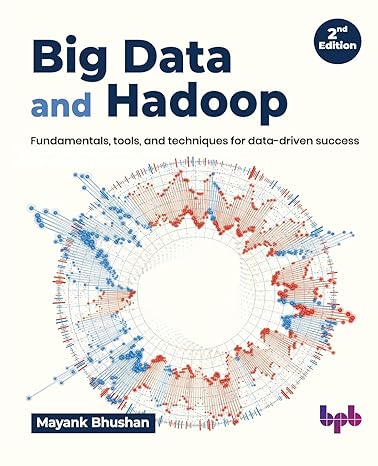Answered step by step
Verified Expert Solution
Question
1 Approved Answer
1. public interface QueueADT { /** * Adds one element to the rear of this queue. * * @param element the element to be added
1. public interface QueueADT{ /** * Adds one element to the rear of this queue. * * @param element the element to be added to the rear of this queue */ public void enqueue (T element); /** * Removes and returns the element at the front of this queue. * * @return the element at the front of this queue */ public T dequeue(); /** * Returns without removing the element at the front of this queue. * * @return the first element in this queue */ public T first(); /** * Returns true if this queue contains no elements. * * @return true if this queue is empty */ public boolean isEmpty(); /** * Returns the number of elements in this queue. * * @return the integer representation of the size of this queue */ public int size(); /** * Returns a string representation of this queue. * * @return the string representation of this queue */ public String toString(); }
2. public class LinkedQueueimplements QueueADT { private int count; private LinearNode front, rear; /** * Creates an empty queue. */ public LinkedQueue() { count = 0; front = rear = null; } /** * Adds the specified element to the rear of this queue. * * @param element the element to be added to the rear of this queue */ public void enqueue (T element) { } /** * Removes the element at the front of this queue and returns a * reference to it. Throws an EmptyCollectionException if the * queue is empty. * * @return the element at the front of this queue * @throws EmptyCollectionException if an empty collection exception occurs */ public T dequeue() throws EmptyCollectionException { } /** * Returns a reference to the element at the front of this queue. * The element is not removed from the queue. Throws an * EmptyCollectionException if the queue is empty. * * @return a reference to the first element in * this queue * @throws EmptyCollectionsException if an empty collection exception occurs */ public T first() throws EmptyCollectionException { } /** * Returns true if this queue is empty and false otherwise. * * @return true if this queue is empty and false if otherwise */ public boolean isEmpty() { } /** * Returns the number of elements currently in this queue. * * @return the integer representation of the size of this queue */ public int size() { } /** * Returns a string representation of this queue. * * @return the string representation of this queue */ public String toString() { } }
3.
public class LinearNode{ private LinearNode next; private E element; /** * Creates an empty node. */ public LinearNode() { next = null; element = null; } /** * Creates a node storing the specified element. * * @param elem the element to be stored within the new node */ public LinearNode (E elem) { next = null; element = elem; } /** * Returns the node that follows this one. * * @return the node that follows the current one */ public LinearNode getNext() { return next; } /** * Sets the node that follows this one. * * @param node the node to be set to follow the current one */ public void setNext (LinearNode node) { next = node; } /** * Returns the element stored in this node. * * @return the element stored in this node */ public E getElement() { return element; } /** * Sets the element stored in this node. * * @param elem the element to be stored in this node */ public void setElement (E elem) { element = elem; } }
4
public class EmptyCollectionException extends RuntimeException { /** * Sets up this exception with an appropriate message. * @param collection String representing the name of the collection */ public EmptyCollectionException (String collection) { super ("The " + collection + " is empty."); } } 5
public class TestQueue { public static void main(String[] args) { LinkedQueue Q = new LinkedQueue(); if (Q.isEmpty()) { System.out.println("Test 1 passed - isEmpty()"); } else { System.out.println("Test 1 failed - isEmpty()"); } Q.enqueue("one"); Q.enqueue("two"); Q.enqueue("three"); Q.enqueue("four"); Q.enqueue("five"); Q.enqueue("six"); Q.enqueue("seven"); Q.enqueue("eight"); Q.enqueue("nine"); if (Q.size() == 9) { System.out.println("Test 2 passed - size()"); } else { System.out.println("Test 2 failed - size()"); } String firstElem = Q.first(); if (firstElem.equals("one")) { System.out.println("Test 3 passed - first()"); } else { System.out.println("Test 3 failed - first()"); } // Dequeue several elements. for (int i = 0; i 6
public class Snail { public static char icon = '@'; private int position; private QueueADT movePattern; public Snail (int[] pattern) { } public void move () { } public int getPosition () { } public void display () { } } 7
public class SnailRace { private Snail[] participants; public static int raceLength = 50; public SnailRace () { participants = new Snail[3]; participants[0] = new Snail(new int[] {1, 0, 1, 2, 1, 0}); participants[1] = new Snail(new int[] {2, 1, 1, 0}); participants[2] = new Snail(new int[] {0, 0, 3}); try { startRace(); } catch (Exception e) { System.out.println("An error occurred."); } } public void startRace () throws InterruptedException { boolean racing = true; while (racing) { for (int i = 0; i 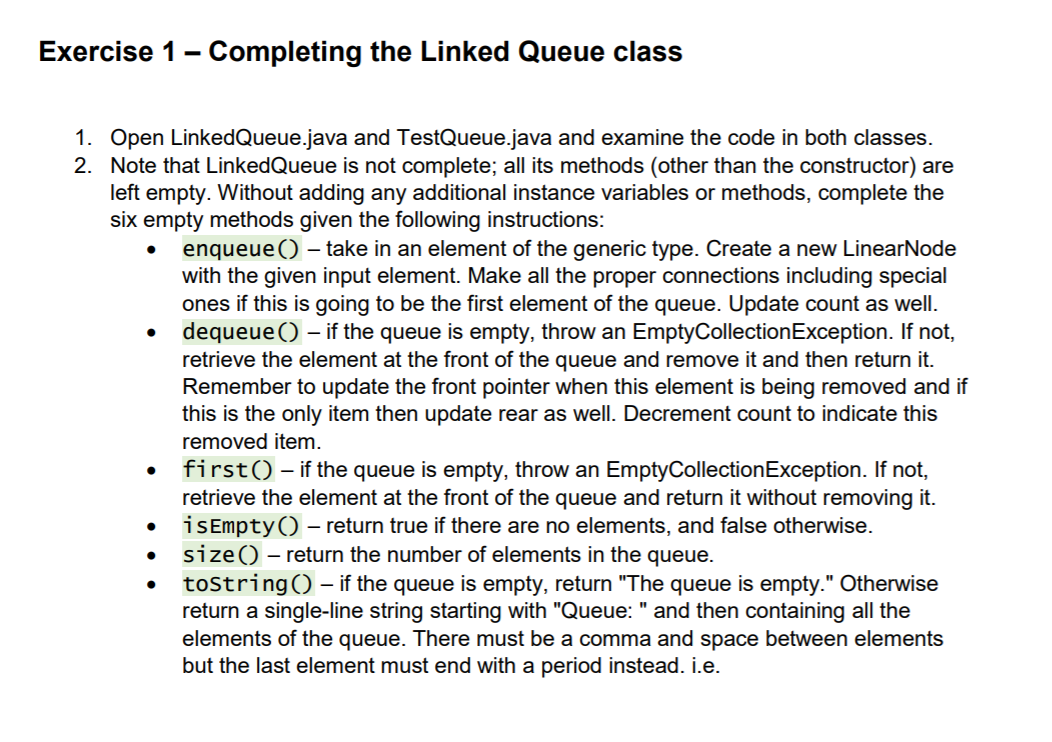
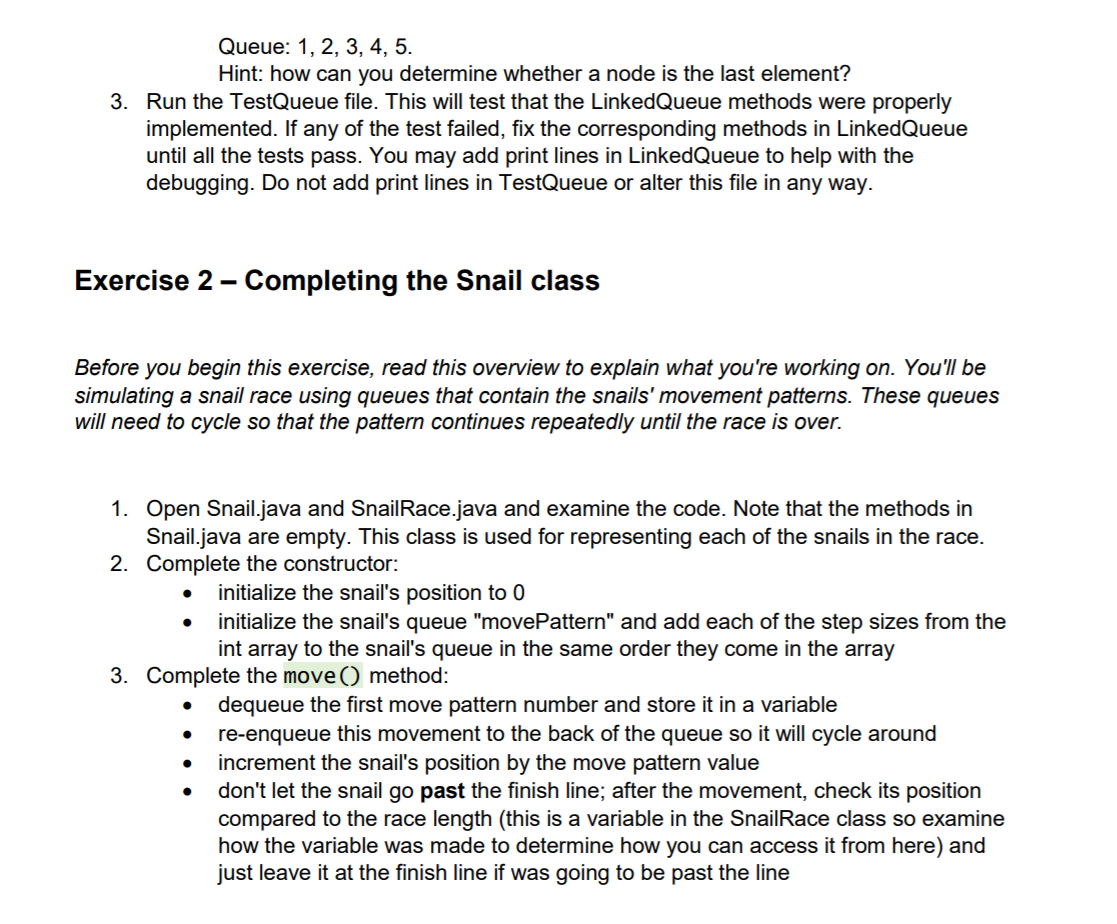
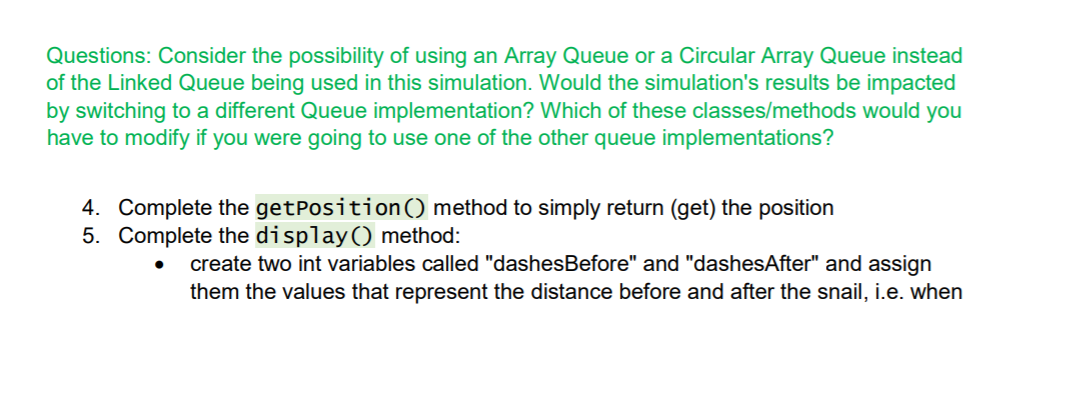
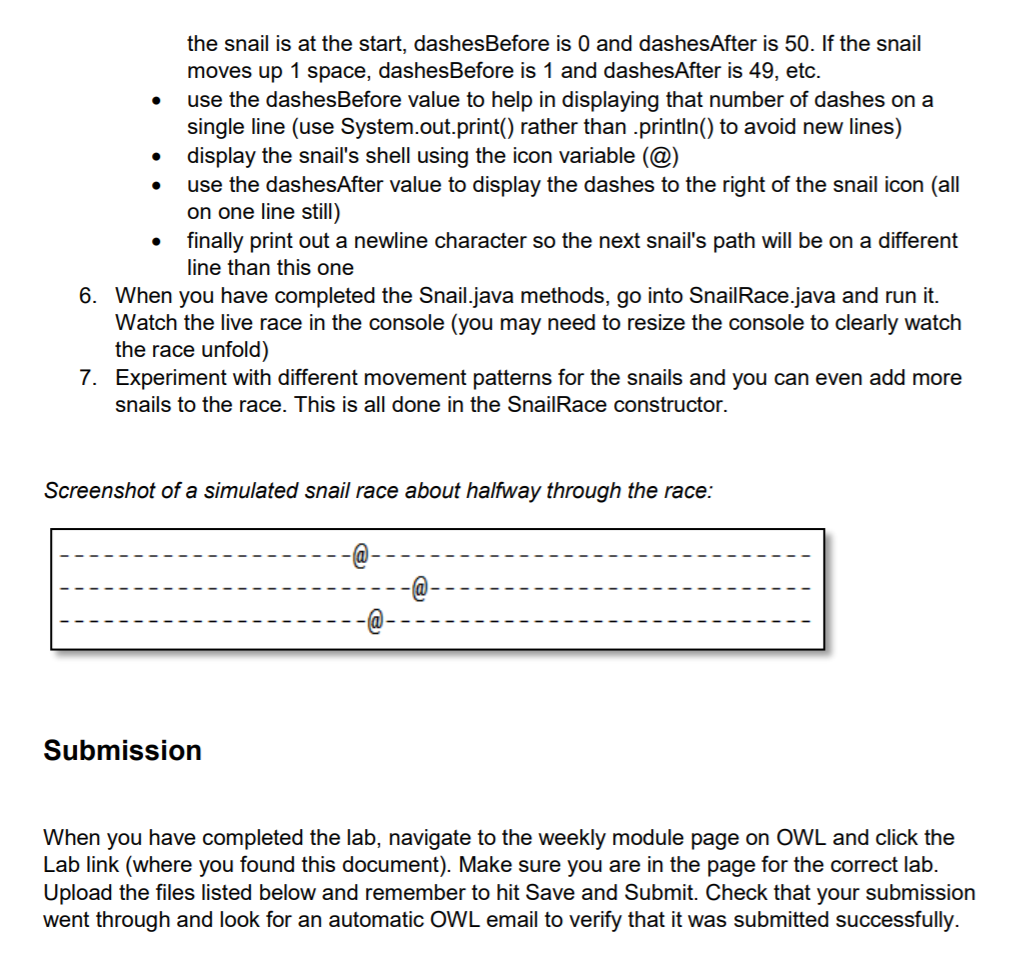
Exercise 1 - Completing the Linked Queue class 1. Open LinkedQueue.java and TestQueue.java and examine the code in both classes. 2. Note that LinkedQueue is not complete; all its methods (other than the constructor) are left empty. Without adding any additional instance variables or methods, complete the six empty methods given the following instructions: enqueue () take in an element of the generic type. Create a new LinearNode with the given input element. Make all the proper connections including special ones if this is going to be the first element of the queue. Update count as well. dequeue () - if the queue is empty, throw an Empty CollectionException. If not, retrieve the element at the front of the queue and remove it and then return it. Remember to update the front pointer when this element is being removed and if this is the only item then update rear as well. Decrement count to indicate this removed item. first() if the queue is empty, throw an EmptyCollectionException. If not, retrieve the element at the front of the queue and return it without removing it. isEmpty() return true if there are no elements, and false otherwise. size() - return the number of elements in the queue. toString() - if the queue is empty, return "The queue is empty." Otherwise return a single-line string starting with "Queue: " and then containing all the elements of the queue. There must be a comma and space between elements but the last element must end with a period instead. i.e. . Queue: 1, 2, 3, 4, 5. Hint: how can you determine whether a node is the last element? 3. Run the TestQueue file. This will test that the LinkedQueue methods were properly implemented. If any of the test failed, fix the corresponding methods in LinkedQueue until all the tests pass. You may add print lines in LinkedQueue to help with the debugging. Do not add print lines in TestQueue or alter this file in any way. Exercise 2 - Completing the Snail class Before you begin this exercise, read this overview to explain what you're working on. You'll be simulating a snail race using queues that contain the snails' movement patterns. These queues will need to cycle so that the pattern continues repeatedly until the race is over. 1. Open Snail.java and SnailRace.java and examine the code. Note that the methods in Snail.java are empty. This class is used for representing each of the snails in the race. 2. Complete the constructor: initialize the snail's position to 0 initialize the snail's queue "movePattern" and add each of the step sizes from the int array to the snail's queue in the same order they come in the array 3. Complete the move() method: dequeue the first move pattern number and store it in a variable re-enqueue this movement to the back of the queue so it will cycle around increment the snail's position by the move pattern value don't let the snail go past the finish line; after the movement, check its position compared to the race length (this is a variable in the SnailRace class so examine how the variable was made to determine how you can access it from here) and just leave it at the finish line if was going to be past the line . . Questions: Consider the possibility of using an Array Queue or a Circular Array Queue instead of the Linked Queue being used in this simulation. Would the simulation's results be impacted by switching to a different Queue implementation? Which of these classes/methods would you have to modify if you were going to use one of the other queue implementations? 4. Complete the getPosition () method to simply return (get) the position 5. Complete the display() method: create two int variables called "dashesBefore" and "dashesAfter" and assign them the values that represent the distance before and after the snail, i.e. when . the snail is at the start, dashesBefore is O and dashesAfter is 50. If the snail moves up 1 space, dashesBefore is 1 and dashesAfter is 49, etc. use the dashesBefore value to help in displaying that number of dashes on a single line (use System.out.print() rather than .println() to avoid new lines) display the snail's shell using the icon variable (@) use the dashesAfter value to display the dashes to the right of the snail icon (all on one line still) finally print out a newline character so the next snail's path will be on a different line than this one 6. When you have completed the Snail.java methods, go into SnailRace.java and run it. Watch the live race in the console (you may need to resize the console to clearly watch the race unfold) 7. Experiment with different movement patterns for the snails and you can even add more snails to the race. This is all done in the SnailRace constructor. Screenshot of a simulated snail race about halfway through the race: -@ Submission When you have completed the lab, navigate to the weekly module page on OWL and click the Lab link (where you found this document). Make sure you are in the page for the correct lab. Upload the files listed below and remember to hit Save and Submit. Check that your submission went through and look for an automatic OWL email to verify that it was submitted successfully Step by Step Solution
There are 3 Steps involved in it
Step: 1

Get Instant Access to Expert-Tailored Solutions
See step-by-step solutions with expert insights and AI powered tools for academic success
Step: 2

Step: 3

Ace Your Homework with AI
Get the answers you need in no time with our AI-driven, step-by-step assistance
Get Started


